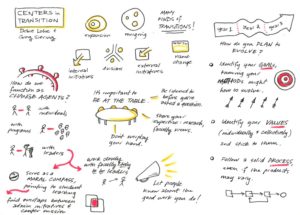
This week we learned about sketchnotes. I love the premise and the idea behind it and I have definitely used it in the past. However, I personally do not like the technique, it isn’t for me. I find it takes too long, it too arduous, and makes my hand sore. I enjoy writing my notes out by hand and having them colour coded and using many sticky notes to emphasize topics. Nevertheless, I despise drawing and get frustrated with the amount of time it takes. Now, just because I don’t enjoy sketchnoting doesn’t mean that it isn’t good, in fact it is probably a better way for me to take notes – even though I know that I still don’t do it.
I recognize how useful it is, and in a classroom I would encourage students to try it and see if it works for them without revealing my opinion on it and allowing the students to have that choice. There are studies that demonstrate how useful sketchnoting can be (1,2). Sketchnotes allow students to make big complex ideas more concrete and succinct through drawing them out (1,2). The act of drawing them out also helps the students consolidate the ideas and have a better recall for them (1,2). In oarticular this type of note taking would be useful for students with learning disabilities such as dyslexia or other processing and language impairment disorders (3). With this in mind I would encourage all students to try many different types of taking notes including sketchnoting because I will never know what will work best for them.
- Fernández-Fontecha, A., O’Halloran, K. L., Tan, S., & Wignell, P. (2019). A multimodal approach to visual thinking: the scientific sketchnote. Visual Communication, 18(1), 5–29. https://doi.org/10.1177/1470357218759808
- Bruff, D. (2014, July 14). Why Use Sketchnotes in the Classroom? Retrieved November 19, 2020, from https://derekbruff.org/?p=2902
- Ukrainetz, T. A. (2019). Sketch and Speak: An Expository Intervention Using Note-Taking and Oral Practice for Children With Language-Related Learning Disabilities. Language, Speech, and Hearing Services in Schools, 50(1), 53-70. doi:10.1044/2018_LSHSS-18-0047